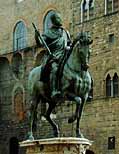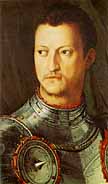Duke and later Grand Duke of Tuscany
Villa at Castello 1519 - 1574
The son of Giovanni dalle Bande Nere and Maria
Salviati, who was also grand-daughter of Lorenzo the Magnificent, Cosimo
was to finally reunite the blood of both branches of the family. He was
placed in power immediately after the assassination of Duke Alessandro by
the magnates of the city (Filippo Strozzi, Niccolò
Acciaiuoli, Baccio Valori and Francesco Guicciardini, who perhaps
hoped he would marry his daughter Lisabetta), who obviously thought
that they would be able to condition this nineteen year old boy,
who had been brought up in the country, as they wished. They were
quite wrong: Cosimo soon showed his true temperament and, with an
able strategem, managed to concentrate all the power in his own hands.
Led by the Strozzi family, his opponents took up arms against him
but were beaten at the battle of Montemurlo on July 31st 1537.
Having ensured his throne, Cosimo re-established law and order within the State,
promoting justice and protecting the weaker members of the community. He encouraged
the growth of trade and industry, started to reclaim the swampy land of the Maremma,
founded the Order of the Knights of St. Stephen to ward off the threat of the
Barbary pirates and organized a Tuscan militia so as not to have to call in mercenary
troops.

Equestrian statue -
Piazza Signoria
In 1539 he married the beautiful and extremely rich daughter of the Viceroy
of Naples, Eleonora of Toledo, who gave him eleven children and the royal
palace at Pitti (she died with her sons
Giovanni and Garzia in 1562, when she was only forty; all three of them
struck down by malarial fever while travelling to Pisa).
Meanwhile Giorgio Vasari designed the Uffizi and
transformed Palazzo Vecchio (the seat of the
government and initially also the home of the Ducal family) with decorations
that celebrated the sovereign and his house, Benvenuto Cellini cast
his Perseus (1545-54) and Ammannati built the new Bridge at Santa Trinita (1566),
after the flood of 1557 had swept the old one away. A new fever for art and building
invaded the entire city.
Thanks to the support of the Empire, Cosimo later managed to conquer Siena and,
after having come close to being offered the crown by the Corsi family in 1567,
he was finally given the long desired title of Grand Duke (1569) by Pope Pius
V and later by the Emperor Maximilian II, which gave him kingly rights; he
also managed to arrange an Imperial marriage for his eldest son Francesco, uniting
him with Joan of Austria, the Emperor's sister. Thus the Medici became
one of the great European dynasties.

